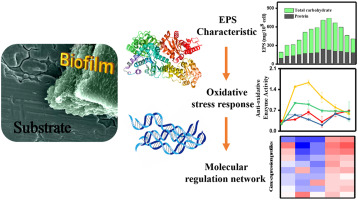当前位置:
X-MOL 学术
›
Environ. Res.
›
论文详情
Our official English website, www.x-mol.net, welcomes your
feedback! (Note: you will need to create a separate account there.)
Bacterial response mechanism during biofilm growth on different metal material substrates: EPS characteristics, oxidative stress and molecular regulatory network analysis.
Environmental Research ( IF 7.7 ) Pub Date : 2020-04-01 , DOI: 10.1016/j.envres.2020.109451 Jiaping Wang 1 , Guiying Li 1 , Hongliang Yin 1 , Taicheng An 1
Environmental Research ( IF 7.7 ) Pub Date : 2020-04-01 , DOI: 10.1016/j.envres.2020.109451 Jiaping Wang 1 , Guiying Li 1 , Hongliang Yin 1 , Taicheng An 1
Affiliation

|
Overwhelming growth of bacterial biofilms on different metal-based pipeline materials are intractable and pose a serious threat to public health when tap water flows though these pipelines. Indeed, the underlying mechanism of biofilm growth on the surface of different pipeline materials deserves detailed exploration to provide subsequent implementation strategies for biofilm control. Thus, in this study, how bacteria response to their encounters was explored, when they inhabit different metal-based pipeline substrates. Results revealed that bacteria proliferated when they grew on stainless steel (SS) and titanium sheet (Ti), quickly developing into bacterial biofilms. In contrast, the abundance of bacteria on copper (Cu) and nickel foam (Ni) substates decreased sharply by 4-5 logs within 24 h. The morphological shrinkage and shortening of bacterial cells, as well as a sudden 64-fold increase of carbohydrate content in extracellular polymeric substances (EPS), were observed on Cu substrate. Furthermore, generation of reactive oxygen species and fluctuation of enzymatic activity demonstrated the destruction of redox equilibrium in bacteria. Bacteria cultured on Cu substrate showed the strongest response, followed by Ni, SS and Ti. The oxidative stress increased quickly during the growth of bacterial biofilm, and almost all tested metal transporter-related genes were upregulated by 2-11 folds on Cu, which were higher than on other substrates (1-2 folds for SS and Ti, 2-9 folds for Ni). Finally, these behaviors were compared under the biofilm regulatory molecular network. This work may facilitate better understanding different response mechanisms during bacterial biofilm colonization on metal-based pipelines and provide implications for subsequent biofilm control.
中文翻译:

在不同金属材料基质上生物膜生长过程中的细菌响应机制:EPS特性,氧化应激和分子调控网络分析。
当自来水流经这些管道时,细菌生物膜在不同的金属基管道材料上的压倒性增长非常棘手,并严重威胁公共健康。实际上,在不同管道材料表面上生物膜生长的潜在机制值得详细探讨,以提供后续的生物膜控制实施策略。因此,在这项研究中,探索了细菌栖息于不同的基于金属的管道底物时如何应对它们的遭遇。结果显示,细菌在不锈钢(SS)和钛板(Ti)上生长时迅速繁殖,迅速发展成细菌生物膜。相反,在24小时内,铜(Cu)和泡沫镍(Ni)亚状态上的细菌丰度急剧下降了4-5个对数。在铜基质上观察到细菌细胞的形态缩小和缩短,以及细胞外聚合物(EPS)中碳水化合物含量的突然增加64倍。此外,活性氧种类的产生和酶活性的波动证明细菌中氧化还原平衡的破坏。在Cu基质上培养的细菌显示出最强的响应,其次是Ni,SS和Ti。在细菌生物膜的生长过程中,氧化应激迅速增加,几乎所有测试的金属转运蛋白相关基因在铜上均上调2-11倍,高于其他底物(SS和Ti上1-2倍,2- Ni的9折)。最后,在生物膜调节分子网络下比较了这些行为。
更新日期:2020-04-03
中文翻译:

在不同金属材料基质上生物膜生长过程中的细菌响应机制:EPS特性,氧化应激和分子调控网络分析。
当自来水流经这些管道时,细菌生物膜在不同的金属基管道材料上的压倒性增长非常棘手,并严重威胁公共健康。实际上,在不同管道材料表面上生物膜生长的潜在机制值得详细探讨,以提供后续的生物膜控制实施策略。因此,在这项研究中,探索了细菌栖息于不同的基于金属的管道底物时如何应对它们的遭遇。结果显示,细菌在不锈钢(SS)和钛板(Ti)上生长时迅速繁殖,迅速发展成细菌生物膜。相反,在24小时内,铜(Cu)和泡沫镍(Ni)亚状态上的细菌丰度急剧下降了4-5个对数。在铜基质上观察到细菌细胞的形态缩小和缩短,以及细胞外聚合物(EPS)中碳水化合物含量的突然增加64倍。此外,活性氧种类的产生和酶活性的波动证明细菌中氧化还原平衡的破坏。在Cu基质上培养的细菌显示出最强的响应,其次是Ni,SS和Ti。在细菌生物膜的生长过程中,氧化应激迅速增加,几乎所有测试的金属转运蛋白相关基因在铜上均上调2-11倍,高于其他底物(SS和Ti上1-2倍,2- Ni的9折)。最后,在生物膜调节分子网络下比较了这些行为。










































 京公网安备 11010802027423号
京公网安备 11010802027423号